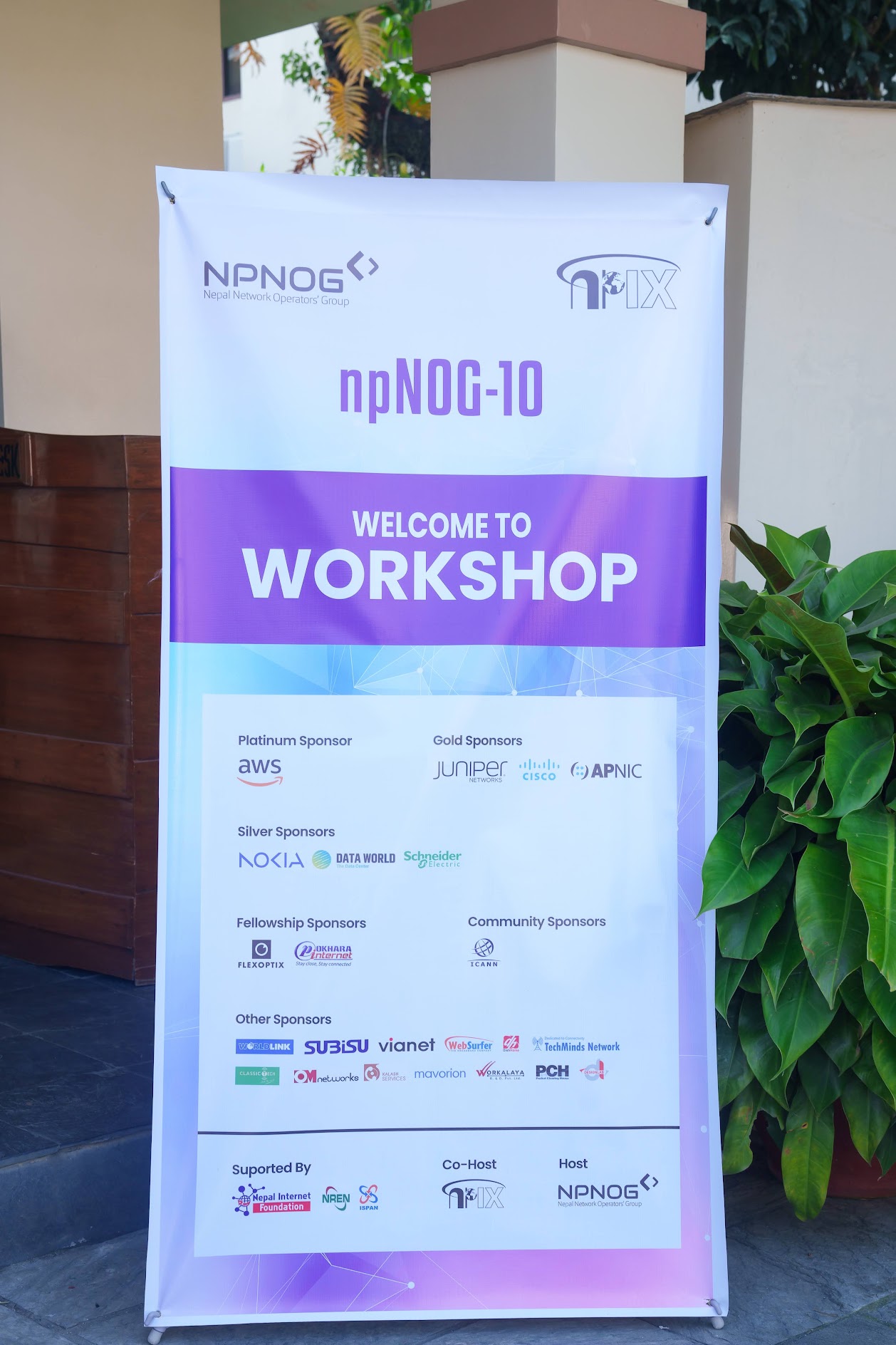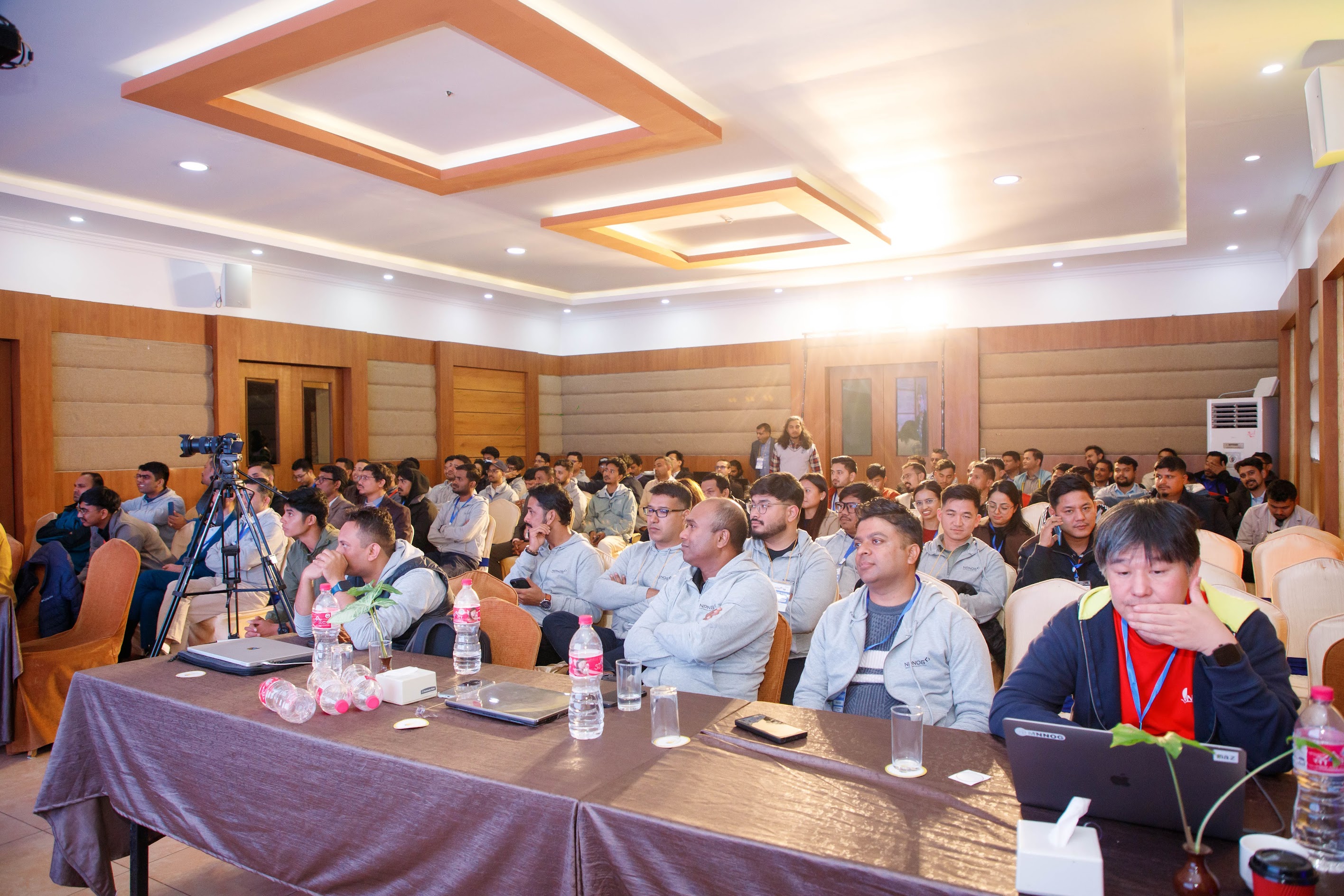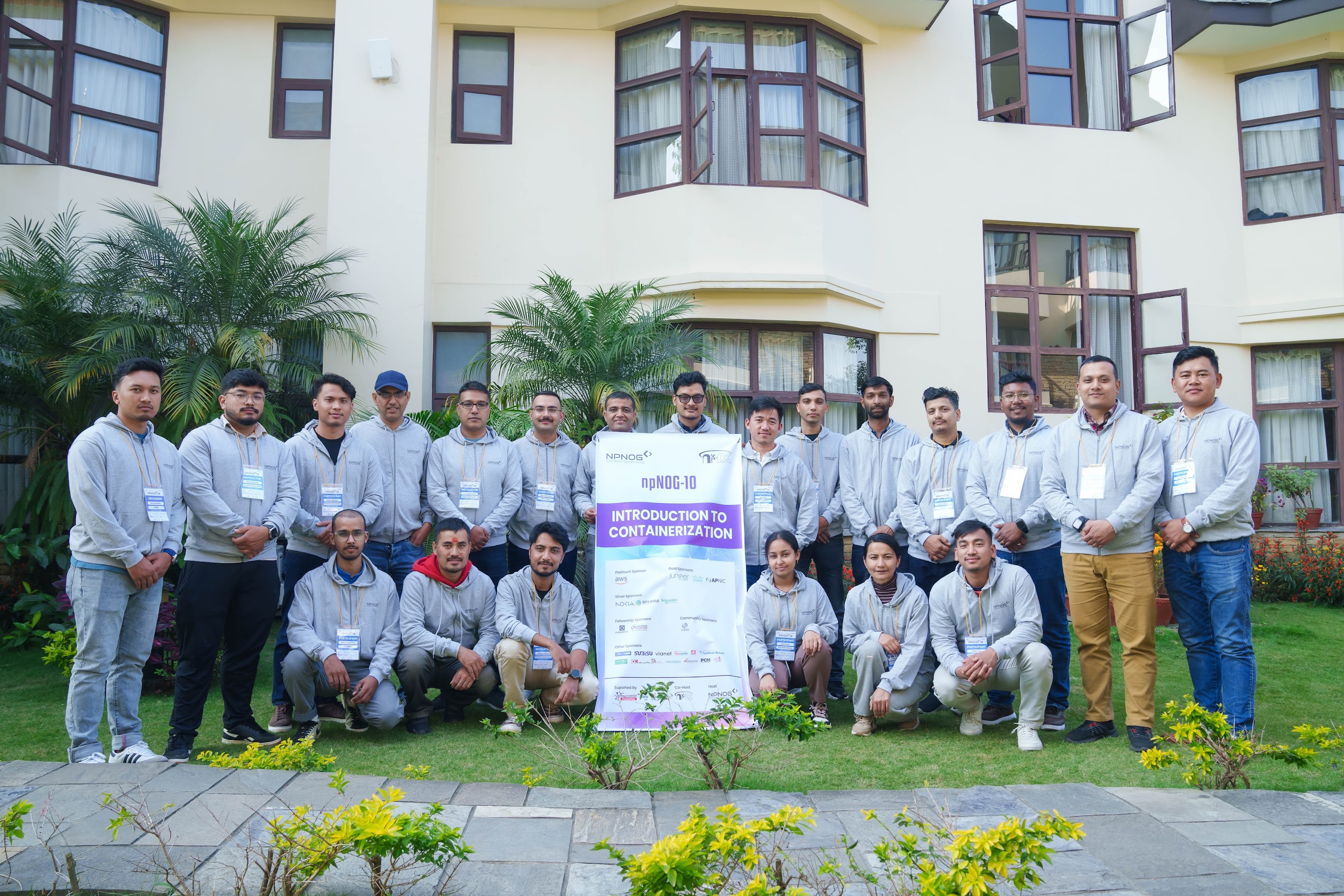
The Unexpected Education
I arrived at npNOG10 expecting a workshop. What I got was something far more valuable—a glimpse into the invisible infrastructure that powers Nepal’s internet and the remarkable people who keep it running.
Being selected as a fellow for npNOG10’s 10th edition felt like winning a lottery ticket to a world I’d only read about. From November 25-29, 2024, Atithi Resort in Lakeside Pokhara became a temporary hub where ISP engineers, network architects, system administrators, academic researchers, and aspiring technologists converged. The event offered three parallel tracks—Network Automation, Advanced Routing, and Containerization. I enrolled in the containerization track, but that’s barely the story worth telling.
The People Who Keep Nepal Online
The ISP Engineer Who Debugs at 3 AM
During a lunch break, I sat next to an engineer from a regional ISP. Between bites of dal bhat, he casually mentioned being woken up at 3 AM the previous week because a major fiber cut had taken down connectivity for an entire district. “We drove two hours in the dark to find the break point,” he said, as if it were the most normal thing in the world.
This wasn’t an isolated story. Throughout the five days, I heard dozens like it—tales of troubleshooting BGP routing issues during festivals, manually rerouting traffic during political protests, coordinating with multiple providers during natural disasters. These were the real-world contexts that textbooks never capture.
What struck me wasn’t just the technical challenges but the weight of responsibility these engineers carry. When they make a configuration mistake, entire communities lose internet access. When they succeed, it’s invisible—nobody notices the internet is working. They operate in a world where excellence means anonymity.
The Woman Breaking Barriers
The fellowship program reserves 50% of spots for promoting diversity in ICT, and I met several women who were leveraging this opportunity. One fellow, a recent engineering graduate, shared how she’d faced skepticism when joining her ISP’s technical team. “They assumed I’d be better suited for customer service,” she told me during an evening walk by the lake.
Six months later, she’d become indispensable to her team’s network automation initiatives. At npNOG10, she wasn’t just learning—she was networking with senior engineers who saw her potential, not her gender. Watching her confidently discuss technical architectures with veterans who initially underestimated her felt like witnessing a small revolution.
These conversations made me realize npNOG isn’t just teaching technical skills; it’s quietly reshaping who gets to build Nepal’s internet infrastructure.
The Trainer Who Could Have Earned More Elsewhere
Our instructors could easily command higher salaries abroad or in private consulting. Yet they chose to spend a week in Pokhara, teaching for modest compensation, because they believed in knowledge transfer. One instructor, who’d worked with major international ISPs, explained: “If Nepal’s internet infrastructure improves, we all benefit. This isn’t charity; it’s investment in our collective future.”
This philosophy permeated the event. Senior engineers patiently answered basic questions from newcomers. Participants from competing ISPs openly discussed technical challenges and solutions. The usual corporate secrecy dissolved, replaced by genuine collaboration.

What Workshops Don’t Teach You
The Politics of Peering
The conference day featured a panel on Internet Exchange Points, and the discussion revealed complexities I’d never considered. Building technical infrastructure is one challenge; convincing competing ISPs to peer with each other is entirely different.
I learned that Nepal’s internet landscape involves delicate negotiations between providers who are simultaneously competitors and collaborators. They compete for customers but must cooperate on infrastructure. An engineer from npIX explained how convincing ISPs to peer locally—rather than routing through international exchanges—requires demonstrating not just technical benefits but economic incentives.
This political dimension of internet infrastructure fascinated me. Technology doesn’t exist in a vacuum; it’s embedded in economic interests, regulatory frameworks, and human relationships. Understanding how to navigate these dynamics matters as much as understanding routing protocols.
The Real Cost of Downtime
During a coffee break, I witnessed an intense discussion between several ISP engineers about backup strategies. One was advocating for additional redundancy; another argued the cost didn’t justify the marginal reliability improvement.
What made the conversation fascinating was how they quantified trade-offs. They weren’t just discussing technical metrics—they were calculating the reputational damage of outages, the customer churn risk, the support ticket volume, the staff overtime costs. Every technical decision had a business impact they had to defend to non-technical managers.
This business-technical translation skill—explaining why investing in infrastructure matters—seemed as crucial as any technical expertise. The engineers who succeeded weren’t just technically proficient; they could articulate technical needs in business language.
The Improvisation Economy
Nepal’s internet infrastructure runs on impressive improvisation. Limited budgets, import difficulties, and geographical challenges force engineers to be creative. I heard stories of:
- Repurposing equipment meant for different use cases
- Building monitoring systems from open-source components because commercial solutions were unaffordable
- Developing local technical expertise because flying in international consultants was prohibitively expensive
- Creating workarounds for equipment that vendors no longer supported
This resourcefulness transforms constraints into innovation. While international ISPs might have dedicated teams and unlimited budgets, Nepali engineers develop versatile problem-solving skills because they must. Watching them discuss creative solutions to resource limitations was like observing engineering jazz—structured fundamentals enabling fluid improvisation.
The Invisible Curriculum
Learning to Learn from Failures
One of the most valuable sessions wasn’t officially on the agenda. During an evening gathering, several engineers shared spectacular failures—misconfigurations that caused outages, upgrades that went wrong, automation scripts that did the opposite of intended.
What made these stories educational wasn’t the technical details but the meta-lessons: how they diagnosed problems under pressure, how they communicated with stakeholders during crises, how they implemented safeguards to prevent recurrence, how they documented incidents for organizational learning.
The vulnerability required to share failures publicly created a psychologically safe environment. If senior engineers could admit mistakes, newcomers felt comfortable asking “stupid questions.” This culture of learning from mistakes might be npNOG’s most valuable tradition.
The Art of Asking Good Questions
I noticed experienced participants asked fundamentally different questions than newcomers. Beginners asked “how” questions—how does this protocol work, how do I configure this feature. Veterans asked “why” and “when” questions—why would you choose this approach over alternatives, when does this solution break down, what are the second-order consequences.
This shift from procedural to strategic thinking marks the transition from technician to engineer. The workshop provided the “how,” but conversations with experienced professionals taught the “why” and “when.” Learning to ask better questions might outlast any specific technical knowledge.
Cross-Pollination Between Tracks
Though I attended the containerization track, some of the most interesting learnings came from interactions with participants in other tracks. During breaks and meals, I’d hear:
- Network automation participants discussing how to script repetitive configurations
- Routing track attendees debating the implications of different BGP policies
- Cross-track discussions about how these technologies interconnect in real deployments
These informal knowledge exchanges revealed how modern infrastructure requires understanding multiple domains. The containerization I was learning about runs on networks configured through automation, which depends on routing that determines traffic flow. Specialists need broad awareness of adjacent domains.

Nepal’s Internet Infrastructure Reality
The Geography Problem
Several discussions circled back to Nepal’s geographical challenges. Building fiber networks across mountainous terrain costs multiples of what it would in flat regions. Natural disasters regularly damage infrastructure. Remote areas remain economically challenging to serve.
These constraints mean Nepal’s internet infrastructure development doesn’t follow standard playbooks. Engineers must balance ideal technical solutions against practical realities. I gained appreciation for why certain technical compromises exist—not from lack of knowledge but from geographical and economic constraints.
Understanding these context-specific challenges made me realize that blindly applying international best practices doesn’t work. Nepal’s engineers are developing context-appropriate solutions that might actually offer insights for other mountainous, developing regions.
The Regulatory Dance
Conference presentations touched on regulatory challenges—spectrum allocation, licensing requirements, infrastructure sharing mandates, content regulations. The relationship between ISPs and regulators appeared complex, sometimes collaborative, sometimes adversarial.
What fascinated me was how technical decisions had regulatory implications and vice versa. Engineers couldn’t just implement optimal technical solutions; they had to navigate regulatory frameworks that weren’t always written with technical realities in mind. This interplay between technology and policy shapes Nepal’s internet landscape in ways I hadn’t previously considered.
The Economics of Small ISPs
Talking with engineers from smaller ISPs revealed a different set of challenges than large providers face. They lacked the negotiating power of major ISPs, struggled with economies of scale, and couldn’t afford redundant infrastructure. Yet they served communities that larger providers found unprofitable.
These small ISPs form a crucial part of Nepal’s internet ecosystem, ensuring broader connectivity despite challenging economics. Their engineers wore multiple hats—handling technical operations, customer support, billing, and business development. The resourcefulness required to keep small ISPs viable was inspiring and humbling.
What Ten Years Means
The Evolution of npNOG
npNOG10 marked a decade of these gatherings, and the anniversary prompted reflection. Early npNOG events focused on basic operational knowledge—how to configure routers, understanding protocols, setting up networks. Recent events address sophisticated topics like automation, security, and modern architectures.
This evolution mirrors Nepal’s internet infrastructure maturation. As the foundational infrastructure stabilized, attention shifted to optimization, security, and adopting contemporary practices. The progression from “getting it working” to “making it excellent” reflects the community’s growth.
Hearing veterans describe npNOG’s journey illustrated how consistent knowledge-sharing events compound over time. Each event builds on previous ones, with participants from earlier editions returning as instructors, creating a sustainable knowledge transfer cycle.
The Community That Emerged
What struck me most was the community npNOG has cultivated. Participants weren’t just attending an event; they were part of an ongoing conversation spanning years. People referenced discussions from npNOG7, built on relationships from npNOG5, continued projects initiated at npNOG8.
This continuity transforms individual events into a sustained community-building effort. The real value isn’t any single workshop but the accumulating relationships, trust, and shared knowledge that persist between events. npNOG created a community where Nepal’s internet builders can be vulnerable about challenges, celebrate successes, and collaborate on solutions.
The Fellowship Experience
Being a fellow meant more than free attendance—it meant being deliberately welcomed into this community. The fellowship program signals that npNOG values fresh perspectives and diverse participants, not just established professionals.
Throughout the event, I never felt like a second-class participant despite being less experienced than many attendees. Senior engineers engaged seriously with fellows, treated our questions as legitimate, and invested time in mentoring. This inclusive culture makes the fellowship program genuinely valuable, not just a diversity checkbox.
The fellow cohort formed particularly strong bonds. We were navigating this experience together, figuring out how we fit into Nepal’s technical community, supporting each other’s learning. Several of us have stayed connected, forming a peer network that continues providing mutual support and learning.
Lakeside Learning
Atithi Resort in Pokhara provided more than a venue—it created an environment conducive to learning and connection. Being away from Kathmandu’s distractions, having accommodation and training in the same location, and experiencing Pokhara’s tranquility together fostered focused engagement.
Early morning walks by the lake became opportunities for reflection and informal discussions. Evening conversations extended long after official sessions ended. The physical environment encouraged the informal interactions where much of the real learning happened.
The organizers’ attention to logistics—reliable internet, comfortable spaces, good food—allowed participants to focus entirely on learning and networking. These practical details matter more than might be obvious; they remove friction and create space for intellectual engagement.
What I’m Taking Forward
A Network, Not Just Knowledge
The containerization skills I learned will become outdated as technologies evolve. But the network of peers, mentors, and community members I connected with will continue providing value throughout my career. When I face challenges, I now know people I can reach out to for advice. When opportunities arise, I have connections who might collaborate.
This shift from seeing professional development as accumulating individual knowledge to building community connections feels significant. Technical skills depreciate; relationships appreciate.
A Different Perspective on Infrastructure
Before npNOG10, I viewed internet infrastructure abstractly—protocols, configurations, systems. Now I see it as fundamentally human—built and maintained by people navigating technical challenges, economic constraints, and social responsibilities.
This humanization of infrastructure makes me appreciate the complexity beyond technology. Understanding why certain technical decisions were made requires understanding the human, economic, and political contexts in which engineers operate.
Questions Worth Pursuing
The event left me with more questions than answers, but better questions:
- How can Nepal develop technical capacity fast enough to keep pace with infrastructure demands?
- What role can smaller ISPs play in Nepal’s connectivity future?
- How do we balance adopting international best practices with developing context-appropriate solutions?
- What does it take to build sustainable technical communities that persist across generations?
These questions don’t have simple technical answers. They require ongoing engagement with Nepal’s internet community—which is precisely what npNOG facilitates.
The Responsibility of Knowledge
Learning creates responsibility. Having gained knowledge and connections through the fellowship program, I feel obligated to contribute back—whether through sharing knowledge, mentoring others, or participating in future npNOG events.
This sense of responsibility to the community seems deliberately cultivated by npNOG. By creating a culture of knowledge sharing and mutual support, they ensure that benefits extend beyond individual participants to the broader ecosystem.
Beyond the Event
npNOG10 wasn’t just five days in Pokhara; it was an initiation into Nepal’s internet infrastructure community. The technical skills matter, but the relationships, perspectives, and sense of belonging to something larger than myself matter more.
For anyone considering future npNOG events: come for the workshops, but stay for the conversations in hallways, at meals, during walks by the lake. The official curriculum teaches techniques; the informal interactions teach wisdom.
The fellowship program made my participation possible, and I’m deeply grateful. But more than the financial support, I appreciate being welcomed into a community that genuinely invests in developing the next generation of Nepal’s internet builders.
As npNOG moves toward its second decade, it’s clear the event serves a crucial role in Nepal’s digital infrastructure development—not just through knowledge transfer but by building the relationships, trust, and community that enable collaboration. In a field often characterized by competition and secrecy, npNOG’s culture of openness and mutual support offers an alternative model worth celebrating and sustaining.
The internet infrastructure that connects Nepal to the world is built and maintained by remarkable people facing unique challenges with creativity, dedication, and impressive resourcefulness. npNOG10 gave me the privilege of meeting these people, learning from them, and hopefully becoming part of this community’s ongoing story.
For more information about npNOG and upcoming events, visit npnog.org.np